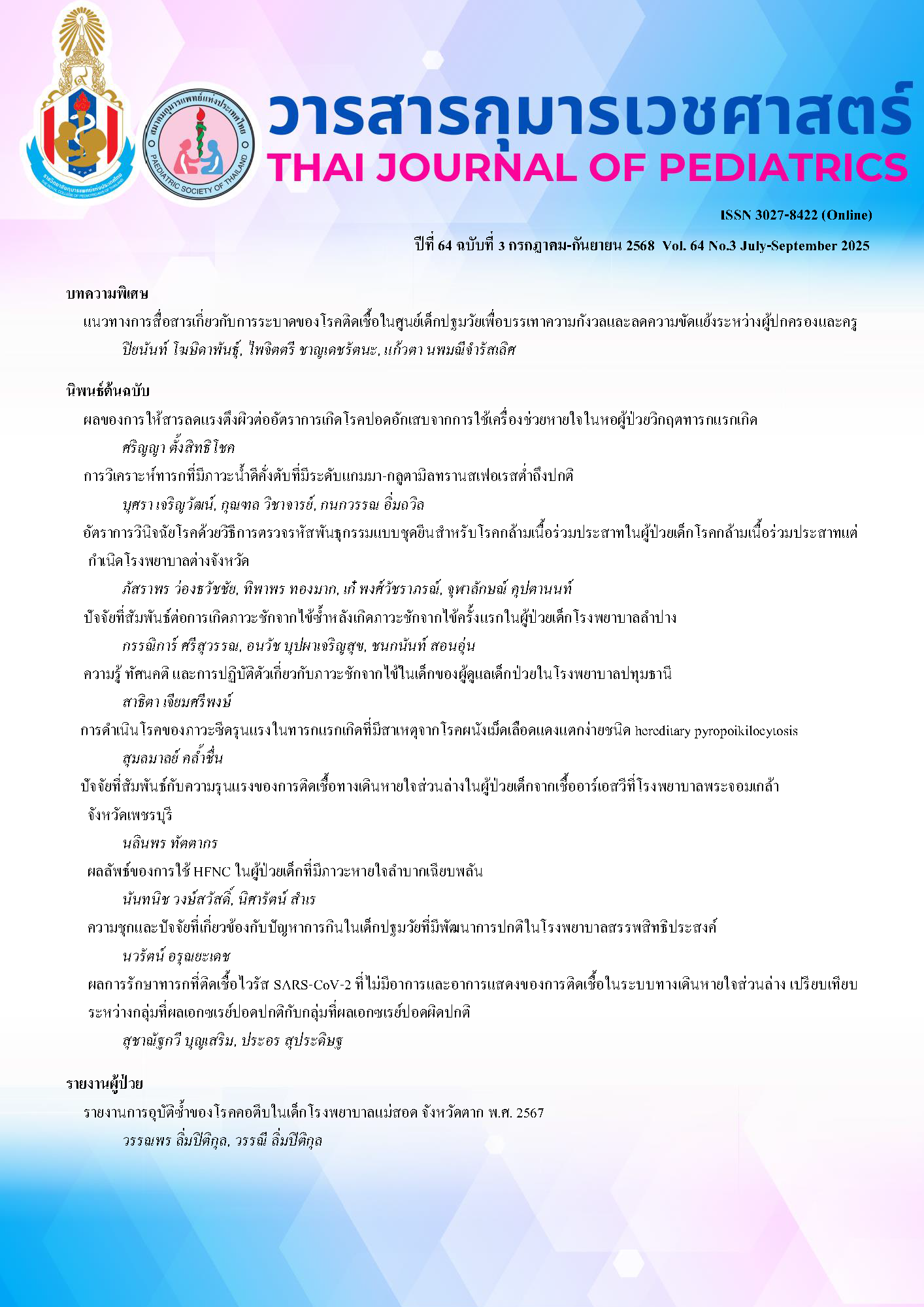Factors associated with the severity of RSV-induced lower respiratory tract infections in children at Phrachomklao Hospital, Phetchaburi
Keywords:
Respiratory syncytial virus, RSV‑LRTI, Bronchiolitis, risk factors of recurrent seizures within 24 hours, Disease severity, Infants, ChildrenAbstract
Background: Respiratory syncytial virus (RSV) is the leading cause of lower respiratory tract infection (LRTI) and hospitalization in young children, with various severities such as bronchiolitis and respiratory failure.
Objective: To identify factors associated with severe RSV‑associated LRTI (RSV‑LRTI) among hospitalized children aged 0–59 months.
Methods: We conducted a retrospective study of children aged 0–59 months hospitalized with laboratory‑confirmed RSV‑LRTI (bronchiolitis or pneumonia) at Phrachomklao Hospital, Phetchaburi, from 1 July 2022 to 31 October 2024. Severe disease was defined as any of: Admission to the pediatric intensive care unit (PICU) and/or need for high‑flow nasal cannula (HFNC), non‑invasive ventilation, or endotracheal intubation. Data were collected from electronic medical records. Associations were assessed by using logistic regression and presented as odds ratios (ORs) with 95% confidence intervals (CIs).
Results: Of 723 RSV‑positive children, 631 had LRTI, 286 were hospitalized, and 220 met inclusion criteria for analysis. Severe disease occurred in 55/220 (25.0%); 44 (24.5%) required HFNC and 11 (5.0%) were intubated; no in‑hospital deaths occurred. Nearly half were <12 months old (103/220, 46.8%); boys constituted 116/220 (52.7%). In crude analyses, asthma remained independently associated with severity (OR 15.5; 95% CI 3.84–62.65; p<0.001); other evaluated factors were not significant.
Conclusion: One of four hospitalized children with RSV‑LRTI had severe disease. Asthma identified a high‑risk subgroup that may benefit from closer monitoring and earlier escalation of respiratory support.
Downloads
References
Vartiainen P, Jukarainen S, Rhedin SA, Prinz A, Hartonen T, Vabalas A, et al. Risk factors for severe respiratory syncytial virus infection during the first year of life: Development and validation of a clinical prediction model. Lancet Digit Health. 2023;5:e821-30.
Andeweg SP, Schepp RM, van de Kassteele J, Mollema L, Berbers GAM, van Boven M. Population-based serology reveals risk factors for RSV infection in children younger than 5 years. Sci Rep. 2021;11:1-8.
Kobiałka M, Jackowska T, Wrotek A. Risk factors for severe respiratory syncytial virus infection in hospitalized children. Viruses. 2023;15:1-24.
Homaira N, Mallitt KA, Oei JL, Hilder L, Bajuk B, Lui K, et al. Risk factors associated with RSV hospitalisation in the first 2 years of life, among different subgroups of children in NSW: A whole-of-population-based cohort study. BMJ Open. 2016;6:1-8.
Shi T, Balsells E, Wastnedge E, Singleton R, Rasmussen ZA, Zar HJ, et al. Risk factors for respiratory syncytial virus associated with acute lower respiratory infection in children under five years: Systematic review and meta-analysis. J Glob Health. 2015;5:1-13.
Lee PI, Liu CC, Hu YL, Chen JM. Seasonality and risk factor analysis of respiratory syncytial virus infection in children in Taiwan-A retrospective study from 1995 to 2005. J Med Virol. 2023;95: 1-10.
Committee on infectious diseases, american academy of pediatrics. Red book: 2024–2027 report of the committee on infectious diseases. Itasca(IL): American academy of pediatrics; 2024:713-21.
Smith DK, Seales S, Budzik C. Respiratory syncytial virus bronchiolitis in children. Am Fam Physician. 2017;95:94-9.
กรมควบคุมโรค. รายงานสถานการณ์โรคติดเชื้อทางเดินหายใจจากเชื้อไวรัสอาร์เอสวี (RSV) [อินเตอร์เน็ต]. กรุงเทพฯ: กรมควบคุมโรค กระทรวงสาธารณสุข; 2566 [เข้าถึงเมื่อ 21 พฤศจิกายน 2567].เข้าถึงได้จาก: http://corewebsite.com/public/dispatch_upload/backend/core_dispatch_324766_7.pdf
Stangthong J. Factors associated with severity of acute respiratory tract infection from respiratory syncytial virus (RSV) in pediatric patients at Hua Hin Hospital. Hua Hin Medical Journal. 2024;4: 1-11.
Sitthikarnkha P, Uppala R, Niamsanit S, Sutra S, Thepsuthammarat K, Techasatian L, et al. Burden of respiratory syncytial virus related acute lower respiratory tract infection in hospitalized Thai children: A 6-year national data analysis. Children (Basel). 2022;9:1990.
Chomcheoy J, Yangai S. Clinical characteristic of hospitalized patients with respiratory syncytial virus induce-lower respiratory tract infection at Maharat Nakhon Ratchasima hospital. Thai J Pediatr. 2021;60:219-26.
Bunjongmanee P. Epidemiology, clinical manifestation and risk factors of respiratory syncytial virus infection in children at Thammasat University Hospital. Thammasat Medical Journal. 2016;16:370-8.
Deng S, Cong B, Edgoose M, De Wit F, Nair H, Li Y. Risk factors for respiratory syncytial virus-associated acute lower respiratory infection in children under 5 years: An updated systematic review and meta-analysis. Int J Infect Dis. 2024;146:1-8.
Cai W, Buda S, Schuler E, Hirve S, Zhang W, Haas W. Risk factors for hospitalized respiratory syncytial virus disease and its severe outcomes. Influenza Other Respir Viruses. 2020;14:658-70.
Stein RT, Bont LJ, Zar H, Polack FP, Park C, Claxton A, et al. Respiratory syncytial virus hospitalization and mortality: Systematic review and meta-analysis. Pediatr Pulmonol. 2017;52:556-69.
Pisesky A, Benchimol EI, Wong CA, Hui C, Crowe M, Belair MA, et al. Incidence of hospitalization for respiratory syncytial virus infection amongst children in Ontario, Canada: A population-based study using validated health administrative data. PLoS One. 2016;11:1-13.
Fitzpatrick T, McNally JD, Stukel TA, Lu H, Fisman D, Kwong JC, et al. Family and child risk factors for early-life RSV illness. Pediatrics. 2021;147:1-14.
İzci Güllü E, Akın Y, Karaaslan A, Vayvada ER, Atabek AA, Kaya Narter F. RSV infection in Istanbul: Risk factors and frequency. J Infect Dev Ctries. 2017;11:691-6.
Downloads
Published
How to Cite
Issue
Section
License
Copyright (c) 2025 The Royal College of Pediatricians Of Thailand

This work is licensed under a Creative Commons Attribution-NonCommercial-NoDerivatives 4.0 International License.



